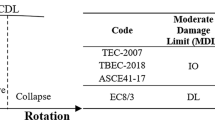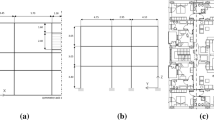Abstract
To achieve a more reliable assessment on structural residual seismic capacity (RSC) in case of sequence-type earthquakes, the procedures for the estimate of the 50-year expectations of RSC ratios of buildings with different importance categories and different precautionary intensities are developed based on the context of the specified uniform collapse probabilities. In accordance with the Chinese design background, the uniform collapse probability corresponding to each case is specified conservatively by its lowest limit as the uncertainty coefficient increases from 0.275 to 0.95. By these specified uniform collapse probabilities, the rare-level and great-level intensities and corresponding peak ground accelerations for all precautionary regions are modified. Further, the combination of local and global structural resilience indexes obtained from RSC ratio curves results in the expectations of Y-year RSC ratios of various buildings. With the assumed linear relation between the expectations and the collapse probability density functions, the expectations of the RSC ratios for different life extensions to 50-year design service life are also provided by corresponding specified uniform collapse probabilities. The efficiency of two types of passive control devices, especially base isolators, for the improvement of structural RSC and resilience is demonstrated by a case study on an 8-story RC frame.
















Similar content being viewed by others
References
An N, He Z (2016) A framework of seismic design based on structural resilience. In: Proceedings of the 2nd international conference on civil, structural and transportation engineering (ICCSTE-2016). Ottawa, Canada
Ancheta TD, Darragh RB, Stewart JP, Seyhan E, Silva WJ, Chiou BSJ, Wooddell KE, Graves RW, Kottke AR, Boore DM, Kishida T, Donahue JL (2014) NGA-West2 database. Earthq Spectra 30(3):989–1005. https://doi.org/10.1193/070913EQS197M
ASCE (2010) Minimum design loads for buildings and other structures. ASCE 7-10, Reston
ATC-63 (2009) Quantification of building seismic performance factors. Applied Technology Council, Washington
CECS 392 (2014) Code for anti-collapse design of building structures. China Planning Press, Beijing (in Chinese)
Chen K, Gao MT (2015) Controlling seismic collapse risk of general construction projects in China mainland. J Build Struct 36(1):23–29. https://doi.org/10.14006/j.jzjgxb.2015.01.003 (in Chinese)
Coliba V, Vacareanu R, Pavel F, Craciun I (2017) Uniform risk-targeted seismic design maps for Romania. In: Proceedings of the 6th national conference on earthquake engineering and the 2nd national conference on earthquake engineering and seismology, Bucharest, Romania, pp 249–256
Douglas J, Ulrich T, Negulescu C (2013) Risk-targeted seismic design maps for mainland France. Nat Hazards 65(3):1999–2013. https://doi.org/10.1007/s11069-012-0460-6
Elenas A, Meskouris K (2001) Correlation study between seismic acceleration parameters and damage indices of structures. Eng Struct 23(6):698–704. https://doi.org/10.1016/S0141-0296(00)00074-2
FEMA P-750 (2009) NEHRP recommended seismic provisions for new buildings and other structures. Federal Emergency Management Agency, Washington
Fiorini E, Bazzurro P, Silva V (2014) Preliminary results of risk-targeted design maps for Italy. In: 2nd European conference on earthquake engineering and seismology, Istanbul, Turkey
Gao MT, Lu SD (2006) Preliminary discussion on the key technologies and principle of the next generation of seismic zoning map. Technol Earthq Disaster Prev 1:1–6 (in Chinese)
GB 50011–2010 (2010) Code for seismic design of buildings. China Architecture & Building Press, Beijing (in Chinese)
GB18306–2015 (2016) Seismic ground motion parameters zonation map of China. Standards Press of China, Beijing (in Chinese)
GB50010–2010 (2011) Code for design of concrete structures. China Architecture & Building Press, Beijing (in Chinese)
GB50223 (2008) Standard for classification of seismic protection of building constructions. China Architecture & Building Press, Beijing (in Chinese)
Ghobarah A, Abou-Elfath H, Biddah A (1999) Response-based damage assessment of structure. Earthq Eng Struct Dyn 28(1):79–104. https://doi.org/10.1002/(SICI)1096-9845(199901)28:1%3c79:AID-EQE805%3e3.0.CO;2-J
Hindi RA, Sexsmith RG (2001) A proposed damage model for RC bridge columns under cyclic loading. Earthq Spectra 17(2):261–290. https://doi.org/10.1193/1.1586175
Jalayer F (2003) Direct probabilistic seismic analysis: implementing non-linear dynamic assessments. In: Ph.D. Dissertation, Department of Civil and Environmental Engineering, Stanford University, Stanford
JBDPA (2001) Guideline for post-earthquake damage evaluation and rehabilitation. The Japan Building Disaster Prevention Association (in Japanese)
Kunnath SK, Reinhorn AM, Abel JF (1991) A computational tool for evaluation of seismic performance of reinforced concrete buildings. Comput Struct 41(1):157–173. https://doi.org/10.1016/0045-7949(91)90165-I
Luco N, Ellingwood BR, Hamburger RO, Hooper JD, Kimball JK, Kircher CA (2007) Risk-targeted versus current seismic design maps for the conterminous United States. In: Proceedings of the SEAOC 76th annual convention. Structural Engineers Association of California, Sacramento, California
Maeda M, Nakano Y, Lee KS (2004) Post-earthquake damage evaluation for R/C buildings based on RSC. In: 13th World conference on earthquake engineering, Paper ID: 1179, Vancouver, Canada
Mazzoni S, McKenna F, Scott MH, Fenves GL (2011) Open system for earthquake engineering simulation (OpenSEES) command language manual. http://opensees.berkeley.edu/wiki/index.php/Command_Manual
Ou JP, He Z, Wu B, Qiu F (1999) Seismic damage performance-based design of reinforced concrete structures. Earthq Eng Eng Vib 19(1):21–30. https://doi.org/10.13197/j.eeev.1999.01.004 (in Chinese)
Park YJ, Ang AHS, Wen YK (1985) Seismic damage analysis of reinforced concrete buildings. J Struct Eng 111(4):740–757. https://doi.org/10.1061/(ASCE)0733-9445(1985)111:4(740)
Park YJ, Ang AHS, Wen YK (1987) Damage-limiting aseismic design of buildings. Earthq Spectra 3(1):1–26. https://doi.org/10.1193/1.1585416
Senate Bill 499 (2009) Hospitals: seismic safety, structural regulations, facilities development division, the building department for California’s hospitals. Office of Statewide Health Planning and Development, Sacramento
Sewell RT, Toro GR, McGuire RK (1991) Impact of ground motion characterization on conservatism and variability in seismic risk estimates. NUREG/CR-6467, U.S. Nuclear Regulatory Commission, Washington
Shi W, Ye LP, Lu XZ, Tang DY (2011) Study on the collapse-resistant capacity of RC frames with different seismic fortification levels. Eng Mech 28(3):41–68 (in Chinese)
Shi W, Lu X, Ye L (2012) Uniform-risk-targeted seismic design for collapse safety of building structures. Sci China Technol Sci 55(6):1481–1488. https://doi.org/10.1007/s11431-012-4808-7
Silva V, Crowley H, Bazzurro P (2016) Exploring risk-targeted hazard maps for Europe. Earthq Spectra 32(2):1165–1186. https://doi.org/10.1193/112514EQS198M
Singhal A, Kiremidjian AS (1996) Method for probabilistic evaluation of seismic structural damage. J Struct Eng 122(12):1459–1467. https://doi.org/10.1061/(ASCE)0733-9445(1996)122:12(1459)
Ulrich T, Negulescu C, Douglas J (2014) Fragility curves for risk-targeted seismic design maps. Bull Earthq Eng 12(4):1479–1491. https://doi.org/10.1007/s10518-013-9572-y
Vacareanu R, Coliba V (2017) Risk-targeted maps for seismic design. A brief review of the state-of-the-art. Romanian J Tech Sci Appl Mech 62(1):80–97
Vacareanu R, Pavel F, Coliba V, Craciun I (2017a) Risk-targeted seismic design maps for Romania. In: Proceedings of the 6th national conference on earthquake engineering and 2nd national conference on earthquake engineering and seismology. Bucharest, Romania, pp 453–460
Vacareanu R, Pavel F, Craciun I, Coliba V, Arion C, Aldea A, Neagu C (2017b) Risk-targeted maps for Romania. J Seismolog 22(2):407–417. https://doi.org/10.1007/s10950-017-9713-x
Vamvatsikos D, Cornell CA (2002) Incremental dynamic analysis. Earthq Eng Struct Dyn 31(3):491–514. https://doi.org/10.1002/eqe.141
Vanzi I, Marano GC, Monti G, Nuti C (2015) A synthetic formulation for the Italian seismic hazard and code implications for the seismic risk. Soil Dyn Earthq Eng 77:111–122. https://doi.org/10.1016/j.soildyn.2015.05.001
Xu JJ, He Z (2016) Influencing factors of incremental damage evolution of reinforced concrete structures subjected to aftershocks. In: Proceedings of the 2nd international conference on civil, structural and transportation engineering (ICCSTE-2016), Ottawa
Acknowledgements
This research was financially supported by the National Natural Science Foundation of China (Grant No. 91315301).
Author information
Authors and Affiliations
Corresponding author
Additional information
Publisher's Note
Springer Nature remains neutral with regard to jurisdictional claims in published maps and institutional affiliations.
Rights and permissions
About this article
Cite this article
He, Z., An, N. & Zhang, Y. The 50-year expectations of structural residual seismic capacity ratios based on uniform collapse probabilities. Bull Earthquake Eng 17, 2459–2484 (2019). https://doi.org/10.1007/s10518-018-00551-7
Received:
Accepted:
Published:
Issue Date:
DOI: https://doi.org/10.1007/s10518-018-00551-7




